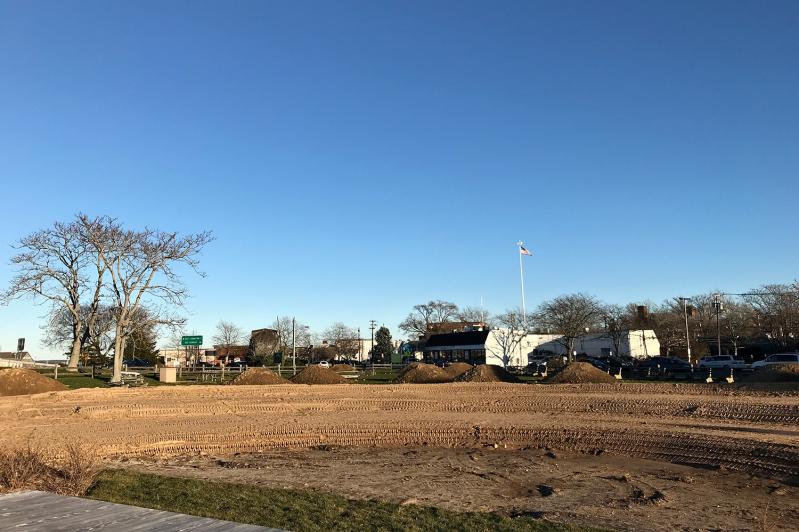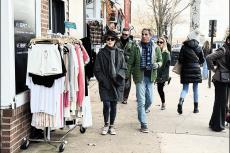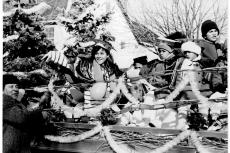An amphitheater, a boardwalk, and Montauk boulders were among the items discussed Tuesday night when Ed Hollander, the landscape architect behind the nascent John Steinbeck Park, at the base of the Lance Cpl. Jordan C. Haerter Veterans Memorial Bridge in Sag Harbor, updated the village board on the project.
“Various piles of topsoil that were dropped . . . and look like Martians invading Sag Harbor, will all get moved into the corner of the property . . . and spread over the finished area before fescue sod is set and two or three rows of native red oak trees planted to start to give us some shade. We hope for that work to be 100-percent complete and ready to use by May 1,” Mr. Hollander said.
“What we’re currently working on, and you can see out there now, is a small sloped seating area. If there was a better word for a small amphitheater, I would use it,” he said. “They’ve done some rough grading on that.”
“Don’t think Greek columns,” said Mayor James Larocca.
Mr. Hollander explained that the sloped seating area will be similar to the seating area at The Church arts center, on Madison Street, which he also landscaped.
“We’re going to use beautiful native boulders from Montauk. They’re putting them through a stone saw and slicing them into six-inch-thick slabs to set into the flat terraces of the amphitheater,” he said. Twenty to 25 such seats will be set, and “reclaimed chunk granite” will be used as steps.
He expects the amphitheater to be complete in the next four to six weeks. The raised semicircular area will be a nice place to watch the sun set over Sag Harbor Cove.
Along with the plantings and sculpting of the land comes a planned boardwalk from the park to Long Wharf so pedestrians need not cross over Route 114.
“The boardwalk is meant to be A.D.A.-compliant,” Mayor Larocca said, referring to the Americans With Disabilities Act. “Rails are essential, particularly for the section under the bridge.” He said it would be preferable to match the railing to that on Long Wharf, but it’s expensive; money would have to be raised.
“Can we also plan to complete that by the first of May as well?” asked the board’s Ed Haye.
“Subject to money dropping from somewhere . . . yes,” Mayor Larocca responded.
Aidan Corish, who handles grant applications for the village, said the search was on for grants that could help connect the bridge to the windmill via boardwalk along the bulkhead. “That’s a big part of our A.D.A. responsibilities . . . to allow people to participate on Long Wharf.”
“It’s great we’re doing all this stuff and beautifying this area, but our concern, me and Ed, is that it’s safe,” said Tom Gardella, the deputy mayor. “If you’re going to start to funnel people under that bridge, that railing has to be in place.”
“Sure,” said Mr. Corish, adding that the grants wouldn’t be in place by May, but he’d explore the options.
“Who is paying for all of this?” asked Bob Plumb, a board member.
“Ed Hollander, who you see sitting there and is a very successful businessman, has been paid exactly nothing for his work,” Mayor Larocca said.
“Basically, Bob, we’re getting all of this work done through contributions,” Mr. Hollander said.
“Diversified Services is providing all the sand for us. Ruddy and Sons Masonry is providing all of the stone. DiSunno Excavation is providing all of the topsoil. And I’ve had two different landscape contractors agree to provide the trees for us. So, hopefully, this all gets done for the same amount that I’m getting paid to do it,” he said.
“We were just getting into higher gear when Covid came along,” Mayor Larocca said. “We lost momentum, but we’re now back in business.”
New Overlay District
In other board news, after closing a particularly passionate public hearing on a law to establish an overlay district in the village’s historically Black neighborhoods, the board voted unanimously to create the district.
Since August, the board had heard competing visions for preserving the community integrity of those neighborhoods.
The Historically Black Beachfront Communities overlay district is the village’s fourth, along with the historic overlay district, tidal flood hazard overlay district, and recently adopted waterfront overlay district. It encompasses 154 acres containing the neighborhoods of Azurest, Sag Harbor Hills, and Ninevah Beach.
The maximum gross floor area of residences in the district cannot exceed 4,000 square feet, and no sidewalks will be installed. Impervious driveways are prohibited, and properties can have a maximum of three accessory buildings or structures.
The district was designed to “preserve the character and scale of the communities, while balancing the need to preserve the equity of long-term homeowners,” according to the law.




